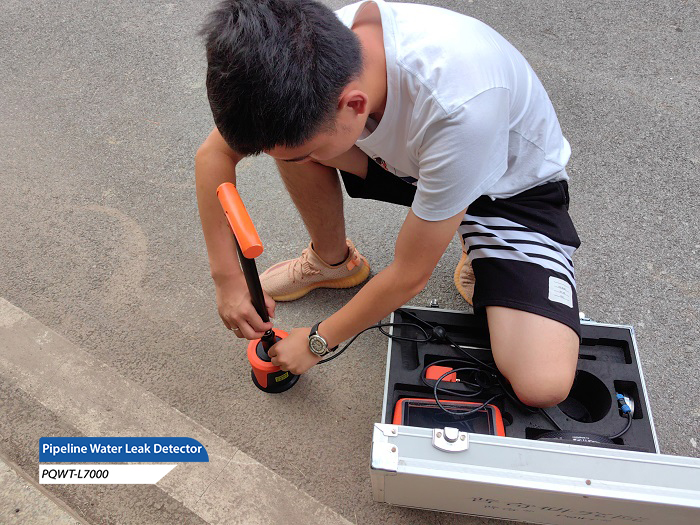With the acceleration of urbanization, the water supply pipeline network is becoming increasingly large, and the problem of pipeline network leakage is becoming more and more prominent. Leakage not only causes a huge waste of water resources, but also brings serious economic losses to the water supply system. Therefore, timely leakage detection and repair is particularly important. This article will reveal the common principles of leakage detection and instrumentation method.

1, sound detection method
Sound detection method is a method to identify the leakage point by capturing the sound changes in the pipeline or equipment. When the pipeline leakage, water impact will produce a specific sound, these sounds can be captured and analyzed by a specific instrument. Commonly used sound detection instruments include noise pipeline leak detector, listen to the leak stick and related leakage pickup instrument. Noise pipeline leak detector can measure and record the intensity and frequency of the sound, to help the inspector quickly locate the leakage point; listen to the leak stick through the conductive sound to the ears of the inspector, so that it can be more intuitive to feel the change of the sound; related to pick up the leakage instrument is the use of the principle of the propagation speed of the sound, through the measurement of sound in the propagation time between the two sensors to determine the location of the leakage point. The relevant leakage picker utilizes the principle of sound propagation speed to determine the location of the leakage point by measuring the sound propagation time difference between the two sensors.
2、Pressure change method
Pressure change method is a method to identify the leakage point by monitoring the pressure change in the pipeline or equipment. When leakage occurs in the pipeline, it will lead to a decrease in pressure in the pipeline. By installing pressure sensors or pressure difference sensors and other equipment, the pressure change of the pipeline can be monitored in real time, so as to determine whether there is a leakage. This method is characterized by high sensitivity and accurate positioning, and is widely used in water supply system leakage detection.
3, flow meter detection method
Flowmeter detection method is a method to detect leakage by monitoring the flow changes in the pipe network. Installation of flow meters or flow sensors in key parts of the pipe network can monitor the flow changes in the pipe network in real time. When the flow rate increases abnormally, it may mean that there is a leakage. This method can realize real-time monitoring of the whole pipe network system, which helps to find and deal with leakage problems in time.
4、Water leakage detection method
Water leakage detection method is a method to determine whether there is a leakage by monitoring the soil moisture change around the underground pipeline. When the pipeline leakage occurs, water will penetrate into the surrounding soil, resulting in an increase in soil moisture. By installing equipment such as moisture sensors, changes in soil moisture can be monitored in real time to determine whether there is a leakage in the pipeline. This method is suitable for leakage detection of underground pipelines, and can effectively avoid damage to the pipeline.
5、Thermal imaging method
Thermal imaging method is the use of infrared thermal imaging camera or thermal imaging camera to detect temperature changes on the surface of the pipe to find the leakage point. When the pipeline leakage occurs, the temperature of the leakage site often changes. By capturing these temperature changes with thermal imaging equipment, the leakage point can be visually identified. This method has the advantages of non-contact, rapid localization, especially suitable for areas that are difficult to approach or observe.
6, chemical tracer method
Chemical tracer method is to inject tracer into the pipe network to detect the leakage method. Tracer can be fluorescent dyes or specific chemicals. When the tracer enters the surrounding environment through the leakage point, it can be sampled and analyzed to determine the location of the leakage point. This method has high accuracy and sensitivity, but the operation process is relatively complex and requires specialized technicians to operate.
7, non-destructive testing technology
Non-destructive testing technology is a non-destructive testing method, including ultrasonic testing, magnetic fluid testing, radar testing and other technologies. These techniques can carry out detailed inspection on the inside and outside of the pipeline without destroying the pipeline structure, so as to find potential leakage points. Nondestructive testing techniques are characterized by high efficiency and accuracy and are widely used in leakage detection of various pipeline systems.
In summary, leakage detection of pipeline network involves a variety of principles and methods. In practical application, appropriate detection methods and instrumentation should be selected according to the specific situation in order to improve the detection efficiency and accuracy. At the same time, strengthening the daily maintenance and management of the water supply system to reduce the occurrence of leakage is also an important measure to ensure the effective use of water resources and the stable operation of the water supply system.








